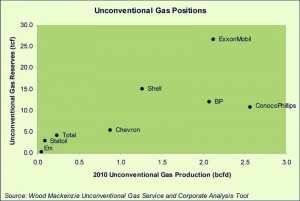Wood Mackenzie report: Majors’ exposure to unconventional gas still relatively small

The majors have recognized the potential of unconventional gas plays as a growth option, evident in recent investments and long-term planning, yet these assets have not yet become transformational for the companies, according to a recent study released by Wood Mackenzie. For the eight majors – BP, Chevron, ConocoPhillips, Eni, ExxonMobil, Shell, Statoil and Total – unconventional gas is typically still less than 10% of reserves.
“As access to new volumes in many parts of the world becomes more challenging, the opportunity to grow production from unconventional gas appears to be very attractive,” the report stated. All of the majors, except for Chevron, have increased production of unconventional gas between 2004 and 2010. In the medium term, Chevron too is expected to increase its unconventional gas production due to the acquisition of Atlas Energy, a major player in the Marcellus Shale.
Wood Mackenzie also noted that, based on assessments of current commercial unconventional gas projects, production from unconventional gas assets is expected to peak before 2016 for many companies. “This highlights the fact that the majors will have to continue to access new unconventional gas opportunities in order to maintain and grow unconventional gas production,” according to the report. Ways to achieve this could include more deals in this sector or application of new technologies to improve well performance.
Looking at exposure to unconventionals in the majors’ portfolios, Wood Mackenzie noted that these companies still have relative small exposure overall: “Even with large corporate acquisitions of key unconventional gas players in North America, ExxonMobil and ConocoPhillips still have less than 11% of their commercial 2P reserves in unconventional gas plays.”
The report categorizes the majors’ investments to grow this exposure into three categories – corporate acquisition, asset acquisition and joint venture.
The first category includes such deals as ConocoPhillips’ purchase of Burlington Resources and ExxonMobil’s purchase of XTO Energy. For the majors, such acquisitions allow the company to obtain resource-rich, economically attractive assets while tapping into the technical talent of smaller firms, built up over thousands of wells.
In the second category, asset acquisitions are more targeted acquisitions of unconventional gas assets. For example, BP purchased 90,000 net acres in the Woodford Shale from Chesapeake Energy and has used the experience to extend its operations in the lower-cost Haynesville and Eagle Ford Shale plays, the report said.
For European majors, joint ventures have been the growth method of choice. “These companies are less familiar with the general operating conditions in the US Lower 48 and relying on existing operators to manage relationships with contractors, regulatory bodies and land owners has proven an effective way to become familiar with running unconventional gas assets,” Wood Mackenzie’s analysis showed. Examples include Eni acquiring a minority stake in the Barnett Shale from Quicksilver Resources and Statoil entering the Marcellus through a partnership with Chesapeake.




